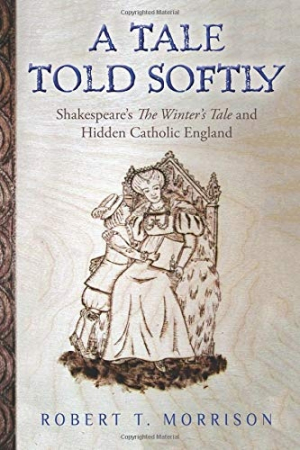A Tale Told Softly
Shakespeare’s The Winter’s Tale and Hidden Catholic England
A Tale Told Softly is a powerful work that reveals the possible real message in William Shakespeare’s The Winter’s Tale.
William Shakespeare may have composed his famous “problem” play The Winter’s Tale for entertainment, but according to Robert Morrison, author of A Tale Told Softly, the Bard may have also been sending a covert pro-Catholic message to Jacobean audiences.
In Shakespeare’s The Winter’s Tale, a king falsely accuses his pregnant queen of infidelity and imprisons her. While audiences would have focused on the story, A Tale Told Softly asserts that the Bard secretly constructed the play as an allegory that criticized how King James I persecuted England’s Catholics. An openly pro-Catholic work would have sent the Bard to prison, but the book shows how that message was hidden.
Shakespearean literary analysis may be an academic subject, but this book is written in clear, engaging prose. The writing style is accessible, which may engage literary scholars as well as keep the interest of a high school student discovering The Winter’s Tale for the first time.
The book’s thesis about a hidden allegory is built upon through explanations of the state of affairs in both Jacobean England and the Catholic Church, dissecting how these align with characters or scenes in the play. The book provides this information in a straightforward manner, keeping its pacing on point.
The book is well-organized, breaking down its points within short, quick-to-read sections. These are supplemented with resources and selections from The Winter’s Tale. There are also timelines of events, including Pope Paul V assuming the papacy and the Gunpowder Plot, which occurred while the play was being written. Other portions of the text cite works from scholars and historians to provide further reference.
The book’s conclusion is powerful. A scene where the persecuted Queen Hermione in The Winter’s Tale asks for a story from another character is compared to the real-life account of a Catholic loyalist writing letters with invisible ink before his real-life execution. The book uses this comparison to show how Shakespeare captured a moment—the anguish and desperation of a persecuted Catholic people at the hands of an unfriendly king—not for the comprehension of his contemporary audience but to simply convey the truth of his time, even if none of his contemporaries understood the message.
A Tale Told Softly is a powerful work that reveals the possible real message in William Shakespeare’s The Winter’s Tale, which speaks to the Bard’s ability to capture universal truths as it sailed past James I’s censors to record a tumultuous time in history.
Reviewed by
Katerie Prior
Disclosure: This article is not an endorsement, but a review. The publisher of this book provided free copies of the book and paid a small fee to have their book reviewed by a professional reviewer. Foreword Reviews and Clarion Reviews make no guarantee that the publisher will receive a positive review. Foreword Magazine, Inc. is disclosing this in accordance with the Federal Trade Commission’s 16 CFR, Part 255.

